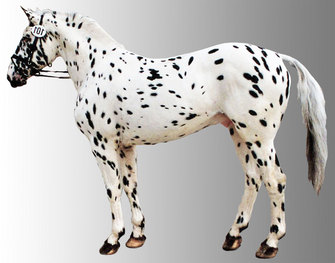« Prev Next »
 So I wrote an article last week on the (now notorious) discovery that a certain cave painting may be more realistic than previously assumed.
So I wrote an article last week on the (now notorious) discovery that a certain cave painting may be more realistic than previously assumed.
To summarize: The research, published in PNAS, focused on a famous and controversial 25,000-year-old cave painting in France called 'The Dappled Horses of Pech-Merle', which shows white horses with black spots. By discovering that this kind of horse actually existed at the time, we now have evidence for white spotted phenotypes in pre-domestic horses. This also has implications for our understanding of the evolution of human culture and cognitio, and, particularly, the evolution of our abstract faculties.
As per the last post, I had an interview which I thought was interesting, wishing I could've included more of it in the article. It was with Derek Hodgson, a cognitive paleontologist at the University of York. What's a cognitive palaeontologist, you ask? Good question. The best description, I think, is that it is a field dedicated to understanding the archaeological record from the perspective of neuroscience and psychology. Take it away Derek:
1. What do you find most exciting about the paper?
The fact that a reliable scientific technique has been employed towards helping to resolve the contentious issue as to whether the two spotted horses at Pech-Merle can be used as evidence to support the shamanistic explanation of Upper Palaeolithic cave art. The shamanistic approach (see Lewis-Williams, Dowson and Jean Clottes) regards the spots of the horses as resulting from the subjective experience of phosphenes (geometric forms derived from the how the visual cortex functions) that appear to become prominent during shamanistic trance states. From this perspective, the cave artists were simply copying such forms that were superimposed on the existing horses. The PNAS paper casts doubt on this theory, which has been dominant over the past twenty years or more, despite vociferous detractors such as myself, Paul Bahn, Patricia Helvenston, Ann Solomon and others. The PNAS paper suggests that the spotted horses existed during the Upper Palaeolithic and were probably an attempt to depict real horses. I made the point in my paper cited in PNAS that those involved in hunting, in order to survive, would have had to be keenly attuned to the main distinguishing features of animals for the purpose of rapid identification. When entering the subdued lighting of the cave their perceptual system would still have been in overdrive for a variety of reasons so that in an environment where the curvilinear cave walls simulate animal outlines the hunters would automatically have seen images of animals projected there (I refer to these as "hyperimages"). The PNAS paper seems to support this reading of events. Interestingly, the spots of the Pech-Merle horses seem to be larger than one would expect on natural horses but this may be a result of the fact that exaggeration of significant features of animals is common in cave art due to the fact that these would have loomed large in the mind's eye of the hunters concerned.
2. Do you take issue with any aspects of the study? Or is there anything you would like to see expanded upon or finessed?
I find the study well argued and compelling. They could have, however, explored the implications of their findings more thoroughly in terms of citing which approach coincides with their results. They also needed to mention that some of the spots on the horses extend beyond the horse outlines of as Lewis-Williams uses this as a means of defending the shamanistic interpretation. This, however, could be another example of exaggerating key features and/or a way of creating a more spectacular visual effect (distortion is also common in cave art). They could also have mentioned that spots and other geometric forms can be found throughout cave art in many different contexts that seem sometimes to be a separate tradition and at others intimately associated with the animal outlines. The spots of the Pech-Merle horses, however, do seem to be of a different order to the run of the mill geometric forms.
3. How does this fit in to what we previously knew about Paleolithic cave art?
It has long been thought that the depicted animals resembled real animals and some evidence for this has been put forward regarding coat colour etc (see Paul Bahn "Journey Through the Ice Age" and R. D. Guthrie 1984 "Ethnological Observations from Palaeolithic Art" in" La contribution de la zoologie et de l'ethologie a l'interpretation de l'art des peoples chasseurs prehistoriques" H.G. Bandi et al (eds) Editions Fribourg: Suisse). Such approaches however have tended to be ignored as the shamanistic interpretation came to dominate. The PNAS paper could, however, herald the restoration of ethnographic approaches to the subject.
4. Particular to you, how will this finding influence research in cognitive archaeology? And, on the other hand, how can cognitive archaeology help explain these findings?
This finding has significance for cognitive archaeology because it brings back into focus questions concerning why the first representational art was so naturalistic when one would have expected the opposite to be the case. The argument I have been pursuing over the past few years tries to show how such depictions were scaffolded, in the way described above, through a dynamic interaction involving the perceptual psychology of the hunter and the suggestive natural formations of the cave environment that parsimoniously accounts for such early naturalism. A further implication for cognitive evolution concerns the issue as to whether animal representations signal some kind of enhanced neural abilities in humans, which has been argued by some scholars. I, myself, am not in agreement with this idea as I regard the depictions as arising in the way described above that also benefitted from growing population levels in Europe at the time where more ideas and practices could be shared leading to greater innovation in number of different areas of expertise.
5. Though many questions remain unanswered, what, in your mind, are the most pressing or interesting issues (or current areas of investigation) in research on cave art?
The most interesting recent issue in terms of my research interest centres on the fact that many of the cave depictions seem to be based on or have been inspired by the actual natural cave contours, blemishes, shadows, stains etc., that can easily be misinterpreted as animals in the subdued lighting of the caves. In fact, many archaeologists are now coming round to the view that the number of depictions that were based on natural features has been grossly underestimated and some archaeologists are now deliberately looking for such features, which has allowed new discoveries to be made even in caves that have been known for a long time (many of the sculptural objects are now also thought to have been originally based on natural features). I make the further claim that because of the implicit way in which the visual brain functions any natural mark in the cave that simulated an animal (referred to as implicit trigger cues) would be enough to provoke hyperimages that were duly fixed through drawing the outlines, which were probably deliberately searched for as part of a quest. Meticulous studies of the order in which lines were drawn seem to support this scenario where the distinguishing features of animals appear to be either drawn first or given priority. It has to be remembered that most of the depictions of animals are in outline and only a minority such as in Lascaux and the Pech-Merle horses are fully fleshed out. Another interesting issue concerns how far back the ability to represent goes. Recent evidence for an early form of "passive" representation involving the minimal enhancement of suggestive naturally occurring rocks dates back to before the Upper Palaeolithic. It may have been the ability to see animal and human figures in rock formations that eventually led to the fully fledged two-dimensional depictions of the Upper Palaeolithic. Incidentally, the first spotted horse at Pech-Merle is also based on a natural feature that resembles the head of a horse.
6. Any other remarks?
Genetic research has been very useful recently in furthering our knowledge of the past, especially in relation to human origins with the advent of many exciting discoveries. To my knowledge, this is the first time genetic research has specifically been applied to understanding palaeoart and provides a welcome new way to study the field.
++
Melanie Pruvost et al., "Genotypes of pre-domestic horses match phenotypes painted in Paleolithic works of cave art," PNAS, 2011.






















